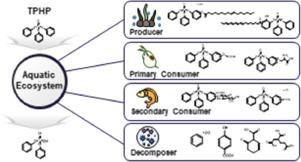Water Research ( IF 12.8 ) Pub Date : 2021-05-05 , DOI: 10.1016/j.watres.2021.117201 Yeowool Choi 1 , Junho Jeon 2 , Sang Don Kim 3

|
Organic pollutants that are introduced into the aquatic ecosystem can transform by various mechanisms. Biotransformation is an important process for predicting the remaining structures of pollutants in the ecosystem, and their toxicity. This study focused on triphenyl phosphate (TPHP), which is a commonly used organophosphate flame retardant and plasticizer. Since TPHP is particularly toxic to aquatic organisms, it is essential to understand its biotransformation in the aquatic environment. In the aquatic ecosystem, based on consideration of the producer-consumer-decomposer relationship, the biotransformation products of TPHP were identified, and their toxicity was predicted. Liquid chromatography-high resolution mass spectrometry was used for target, suspect, and non-target analysis. The obtained biotransformation products were estimated for toxicity based on the prediction model. As a result, 29 kinds of TPHP biotransformation products were identified in the aquatic ecosystem. Diphenyl phosphate was detected as a common biotransformation product through a hydrolysis reaction. In addition, products were identified by the biotransformation mechanisms of green algae, daphnid, fish, and microorganism. Most of the biotransformation products were observed to be less toxic than the parent compound due to detoxification except some products (hydroquinone, beta-lyase products, palmitoyl/stearyl conjugated products). Since various species exist in a close relationship with each other in an ecosystem, an integrated approach for not only single species but also various connected species is essential.
中文翻译:

通过可疑和非目标筛选方法鉴定来自各种水生物种的有机磷酸酯的生物转化产物
引入水生生态系统的有机污染物可以通过各种机制进行转化。生物转化是预测生态系统中污染物的剩余结构及其毒性的重要过程。这项研究的重点是磷酸三苯酯(TPHP),这是一种常用的有机磷酸酯阻燃剂和增塑剂。由于TPHP对水生生物特别有毒,因此必须了解其在水生环境中的生物转化。在水生生态系统中,基于生产者-消费者-分解者之间的关系,确定了TPHP的生物转化产物,并预测了其毒性。液相色谱-高分辨率质谱法用于目标,可疑和非目标分析。基于预测模型,估计获得的生物转化产物的毒性。结果,在水生生态系统中鉴定出29种TPHP生物转化产物。通过水解反应检测到磷酸二苯酯是常见的生物转化产物。此外,产品还通过绿藻,水蚤,鱼类和微生物的生物转化机制进行鉴定。观察到大多数生物转化产物由于排毒而比母体化合物毒性低,除了一些产物(氢醌,β-裂合酶产物,棕榈酰/硬脂酰共轭产物)。由于各种物种在一个生态系统中相互之间存在着紧密的联系,因此,不仅要针对单个物种而且要对各种相互联系的物种进行整合,这是必不可少的。结果,在水生生态系统中鉴定出29种TPHP生物转化产物。通过水解反应检测到磷酸二苯酯是常见的生物转化产物。此外,产品还通过绿藻,水蚤,鱼类和微生物的生物转化机制进行鉴定。观察到大多数生物转化产物由于排毒而比母体化合物毒性低,除了一些产物(氢醌,β-裂合酶产物,棕榈酰/硬脂酰共轭产物)。由于各种物种在一个生态系统中相互之间存在着紧密的联系,因此,不仅要针对单个物种而且要对各种相互联系的物种进行整合,这是必不可少的。结果,在水生生态系统中鉴定出29种TPHP生物转化产物。通过水解反应检测到磷酸二苯酯是常见的生物转化产物。此外,产品还通过绿藻,水蚤,鱼类和微生物的生物转化机制进行鉴定。观察到大多数生物转化产物由于排毒而比母体化合物毒性低,除了一些产物(氢醌,β-裂合酶产物,棕榈酰/硬脂酰共轭产物)。由于各种物种在一个生态系统中相互之间存在着紧密的联系,因此,不仅要针对单个物种而且要对各种相互联系的物种进行整合,这是必不可少的。通过水解反应检测到磷酸二苯酯是常见的生物转化产物。此外,产品还通过绿藻,水蚤,鱼类和微生物的生物转化机制进行鉴定。观察到大多数生物转化产物由于排毒而比母体化合物毒性低,除了一些产物(氢醌,β-裂合酶产物,棕榈酰/硬脂酰共轭产物)。由于各种物种在一个生态系统中相互之间存在着紧密的联系,因此,不仅要针对单个物种而且要对各种相互联系的物种进行整合,这是必不可少的。通过水解反应检测到磷酸二苯酯是常见的生物转化产物。此外,产品还通过绿藻,水蚤,鱼类和微生物的生物转化机制进行鉴定。观察到大多数生物转化产物由于排毒而比母体化合物毒性低,除了一些产物(氢醌,β-裂合酶产物,棕榈酰/硬脂酰共轭产物)。由于各种物种在一个生态系统中相互之间存在着紧密的联系,因此,不仅要针对单个物种而且要对各种相互联系的物种进行整合,这是必不可少的。观察到大多数生物转化产物由于排毒而比母体化合物毒性低,除了一些产物(氢醌,β-裂合酶产物,棕榈酰/硬脂酰共轭产物)。由于各种物种在一个生态系统中相互之间存在着紧密的联系,因此,不仅要针对单个物种而且要对各种相互联系的物种进行整合,这是必不可少的。观察到大多数生物转化产物由于排毒而比母体化合物毒性低,除了一些产物(氢醌,β-裂合酶产物,棕榈酰/硬脂酰共轭产物)。由于各种物种在一个生态系统中相互之间存在着紧密的联系,因此,不仅要针对单个物种而且要对各种相互联系的物种进行整合,这是必不可少的。



























 京公网安备 11010802027423号
京公网安备 11010802027423号